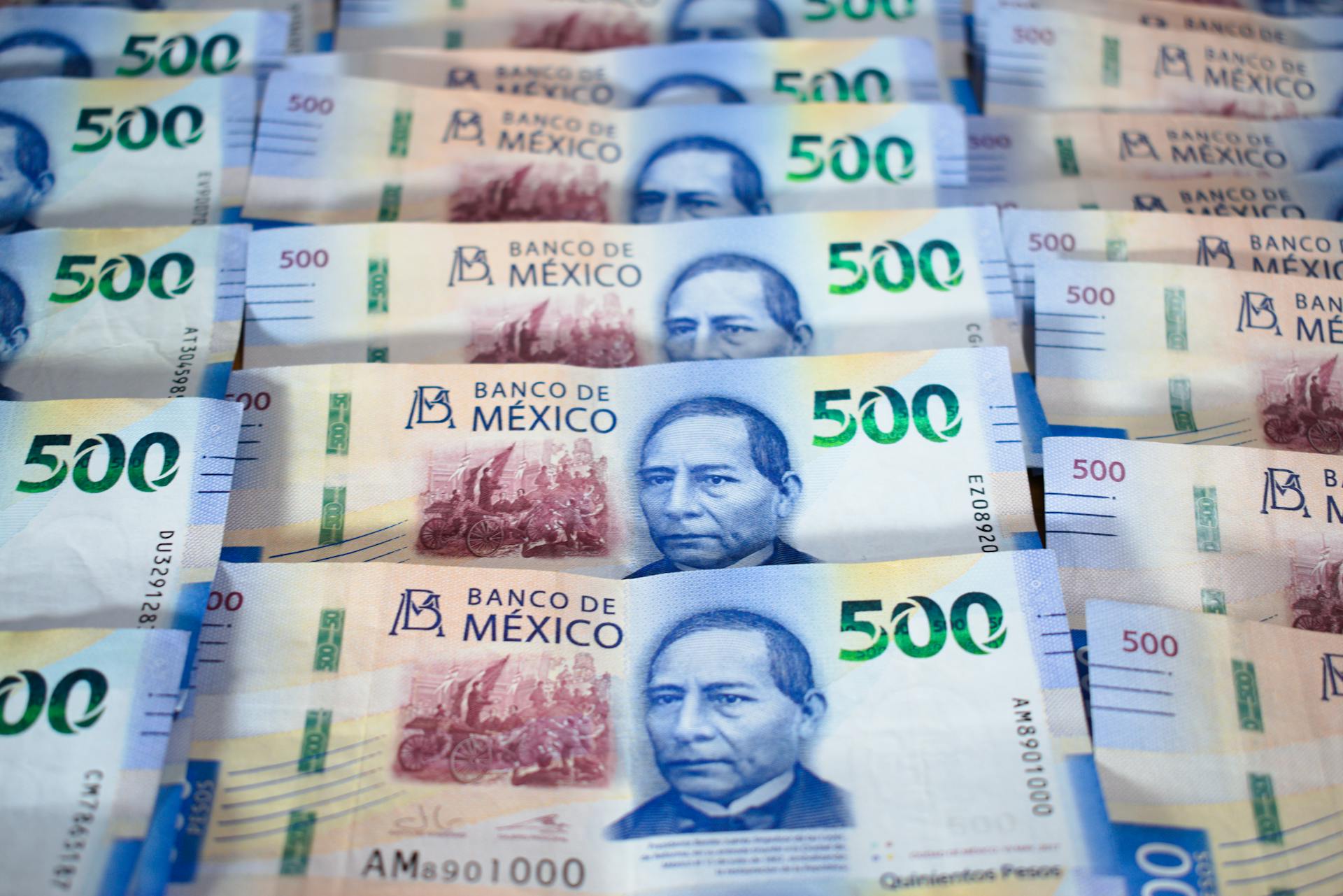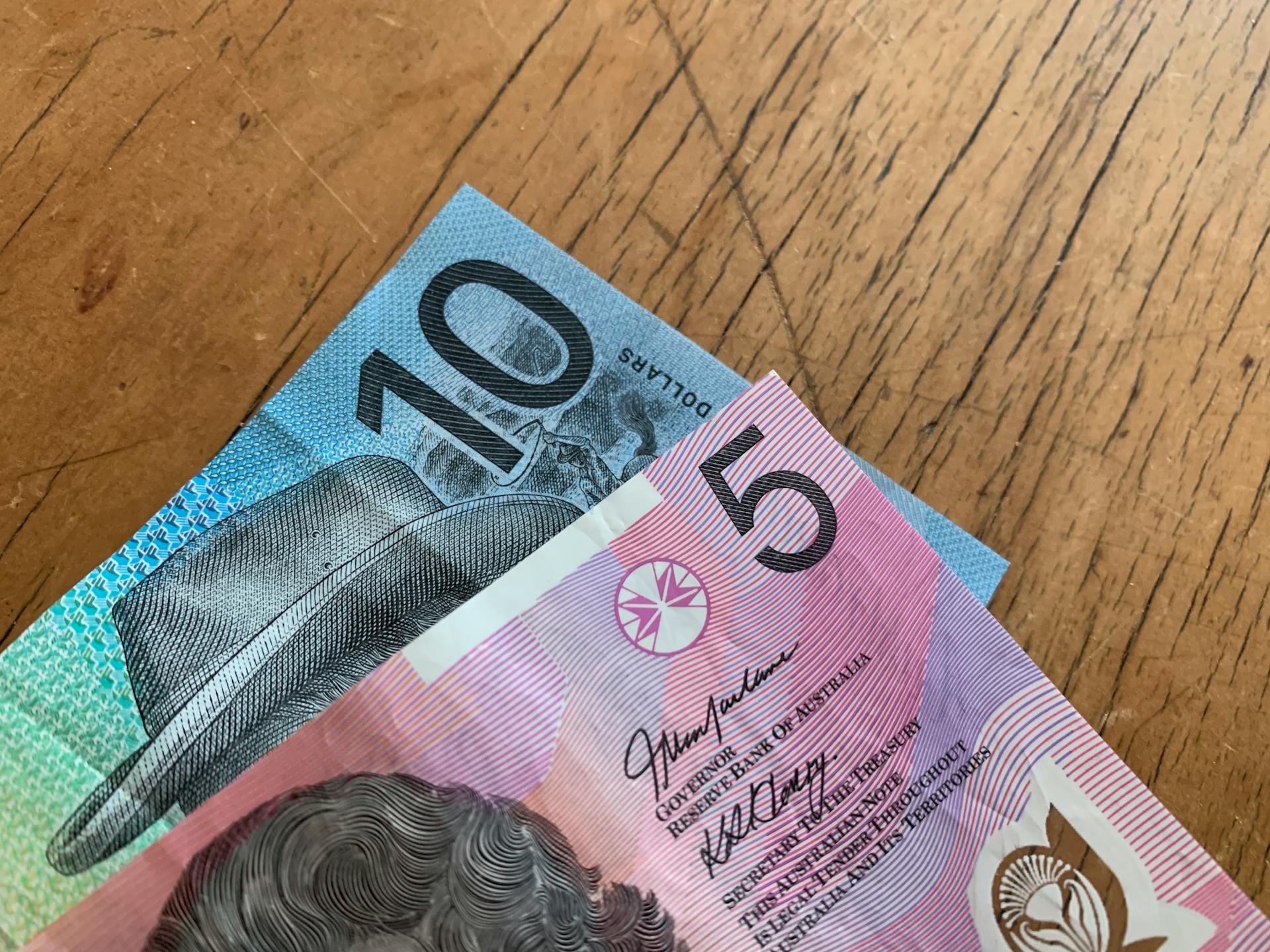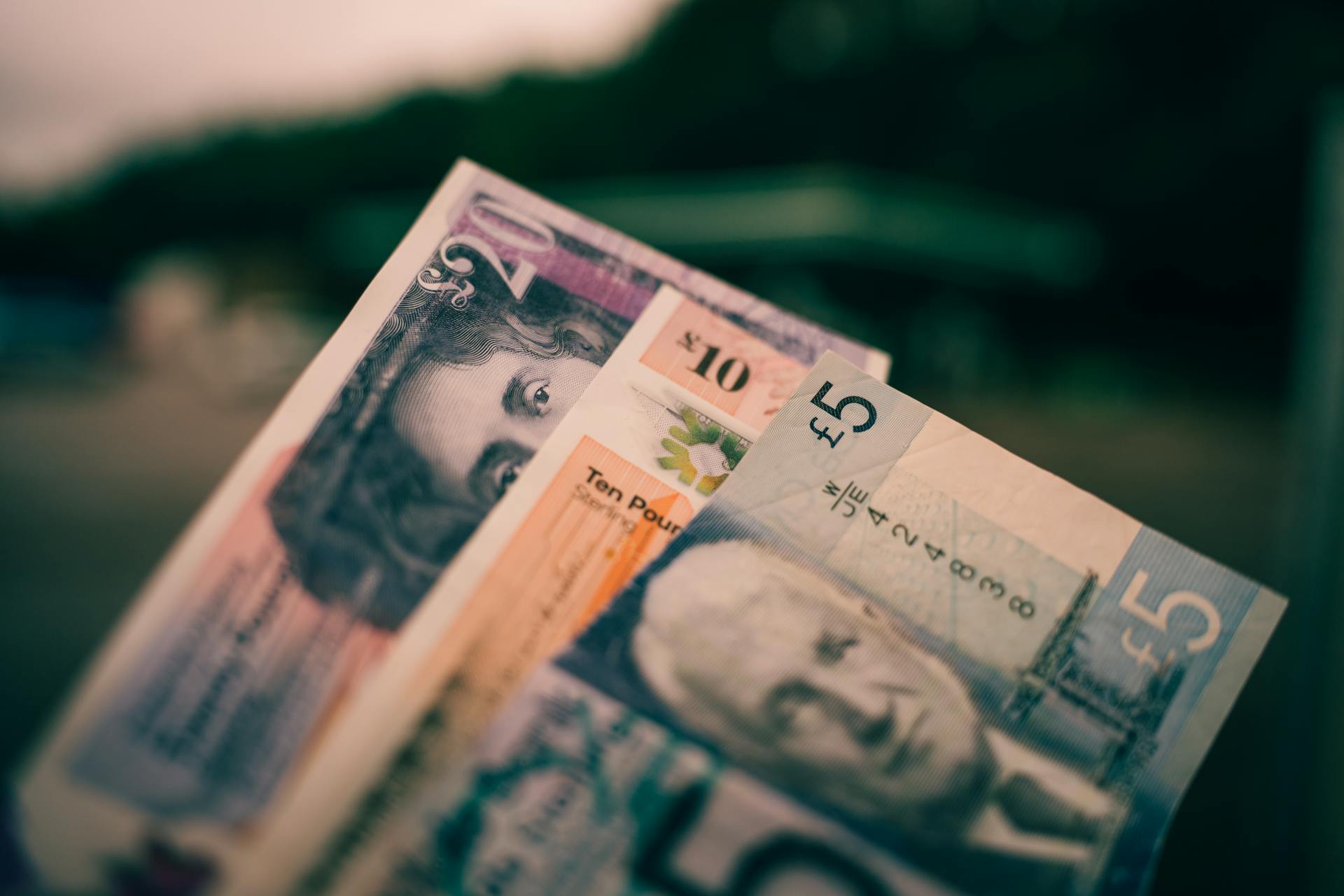
The CHF currency abbreviation is a widely recognized and used symbol for the Swiss Franc.
The Swiss Franc is the official currency of Switzerland and is issued by the Swiss National Bank.
CHF is a three-letter currency code as assigned by the International Organization for Standardization (ISO).
The Swiss Franc is subdivided into 100 subunits called rappen.
For another approach, see: Congo Franc
What is CHF?
The CHF currency abbreviation is a bit of a mystery to some, but it's actually a pretty straightforward acronym. CHF stands for Swiss Franc.
In 1798, the Helvetic Republic was established, and with it came a new currency based on the Berne thaler. This currency was subdivided into 10 batzen or 100 rappen.
The franc introduced during this time was equivalent to 6¾ grams of silver, or 1½ French francs.
Take a look at this: Taux De Change 100 Franc Suisse / Dollar
Switzerland Overview
The Swiss franc, or CHF, is the official currency of Switzerland. It's a stable and widely recognized currency.
The CHF currency coins come in a range of denominations, including 5 francs, 2 francs, 1 franc, ½ franc, 20 centimes, 10 centimes, and 5 centimes. This variety makes it easy to make small purchases or round up to the nearest coin.
Consider reading: Cfa Franc Beac
The most often used banknotes in Switzerland include 10 francs, 20 francs, 50 francs, 100 francs, 200 francs, and 1000 francs. These denominations cover a wide range of transactions, from everyday shopping to larger purchases.
Interestingly, the 1000-franc banknote is the highest circulated bill in Switzerland, making up 61.1% of all banknotes in circulation.
Related reading: Can I Use Euro Currency in Switzerland
Latin Origin
The CHF currency code has a fascinating origin. It comes from the Latin name of the Swiss Confederation, "Confoederatio Helvetica franc".
The letters CHF are a direct translation of the Latin name, making it a unique and interesting aspect of the Swiss franc.
On a similar theme: Swedish Currency Name
History of CHF
The Swiss franc, also known as CHF, has a rich history dating back to the late 18th century. Each canton had its own currency, and there was no standard unit of exchange across the country.
In 1798, the French revolutionary army invaded Switzerland and introduced a new currency called the franc, based on the French franc. However, the Helvetic Republic was short-lived, and in 1803, Switzerland regained its independence. The cantons once again began issuing their own currencies, but the franc remained in use as a standard unit of exchange.
The Swiss franc was established at par with the French franc in 1850, and it became a crucial part of the Latin Monetary Union in 1865, linking its value to the value of silver along with France, Italy, Switzerland, and Belgium.
See what others are reading: French Republic Currency
The History
The Swiss franc has a rich history that spans over two centuries. It all began in the late 18th century when Switzerland was a confederation of independent cantons, each with its own currency.
The French revolutionary army invaded Switzerland in 1798 and introduced the franc, based on the French franc. This marked the beginning of a standardized currency across the country.
In 1848, the Swiss Federal Constitution declared that only the central bank could issue Swiss currency, paving the way for a unified monetary system. The Federal Coinage Act of 1850 confirmed the franc as the official currency of Switzerland.
Between 1865 and the 1920s, Switzerland, France, Italy, and Belgium formed the Latin Monetary Union, linking the values of their currencies to the value of silver. This union remained in effect for over 60 years.
Switzerland's neutrality during World War II made its banks a safe haven for investors and governments, solidifying the Swiss franc's reputation as a stable and secure currency.
A fresh viewpoint: Pound in French
Origin of New Code
The origin of a new currency code is a fascinating process. The government of a country and the official maintenance agency for currency codes must work together to bring it into existence.
A country's two-letter alphabetic code is the starting point, as seen in the example of Zubrowka, which would likely be ZU. A letter representing the currency's name, such as K for klübeck, is then added to it.
The resulting code would be unique, and if it's already taken, alternatives like ZBK would be considered.
For another approach, see: Bahraini Dinar Country
Factors Affecting
The Swiss franc is a relatively stable currency, but its value can fluctuate over time compared to other currencies. This means that the exchange rate of the Swiss franc can change.
Several factors affect the exchange rate of the Swiss franc, including cross-currency rates like EUR/CHF or GBP/CHF. These rates can impact the USD/CHF exchange rate.
Monitoring cross-exchange rates is crucial, as a rise in GBP/CHF brought on by a UK interest rate increase can make the Swiss franc weaker than other currencies.
The exchange rate of the Swiss franc can also be affected by its stability, making it a relatively safe bet for international transactions.
Broaden your view: Great Britain Pound Forecast
National Bank and CHF
The Swiss National Bank, also known as the SNB, has complete autonomy in determining monetary and exchange rate policy. This allows it to create cutting-edge methods for controlling interest rates and managing liquidity.
The SNB's approach to monetary policy is unique, as it doesn't base its decisions on a particular money market rate. Instead, it uses foreign currency swaps and repurchase agreements to affect the money supply and interest rates.
The Swiss franc is a highly traded currency, ranking as the eighth-most-traded currency in the world as of 2022. It accounted for around 5% of all foreign exchange transactions that year.
The Swiss franc is also widely held as a reserve currency, ranking 5th or 6th in value held as reserves after the US dollar, euro, Japanese yen, and pound sterling.
Is the Eighth-Most-Traded
The Swiss franc, or CHF, is a highly traded currency, ranking eighth in the world as of 2022. It accounted for around 5% of all foreign exchange transactions in 2022.
The CHF's popularity can be attributed to its stability and low inflation rate. This makes it a safe-haven asset for investors and a reliable store of value.
In fact, the Swiss franc is the eighth-most-traded currency in the world, not far behind the U.S. dollar (USD), the British pound (GBP), and the Australian dollar (AUD).
National Bank (SNB)
The Swiss National Bank (SNB) is a central bank that has complete autonomy in determining monetary and exchange rate policy.
The SNB has developed cutting-edge methods for controlling interest rates and managing liquidity. These methods include using foreign currency swaps and repurchase agreements to affect the money supply and interest rates.
The SNB does not base its monetary policy on a particular money market rate, unlike most central banks. This approach has significantly impacted the value of the Swiss franc due to the use of foreign exchange swaps.
On a similar theme: Currency Museum of the Bank of Japan
Exchange Rates
The Swiss National Bank (SNB) has a unique approach to monetary policy, not basing it on a particular money market rate like most central banks do. This means they use foreign currency swaps and repurchase agreements to control interest rates and manage liquidity.
The SNB's strategy has a significant impact on the value of the Swiss franc. Its use of foreign exchange swaps has affected the value of the franc in the past.
Cross-currency rates, such as EUR/CHF or GBP/CHF, can occasionally impact the USD/CHF exchange rate. A rise in GBP/CHF can make the Swiss franc weaker than other currencies.
If you're traveling to Switzerland, you'll likely need to exchange your home currency into Swiss francs. Some tourist establishments may accept the euro, but you'll still get change in the local currency.
Carrying cash is not always necessary, as many businesses accept debit cards and credit cards. However, it's a good idea to have some cash on hand, especially for small towns.
To avoid foreign transaction fees, it's essential to check with your bank or credit card provider. If they do charge fees, consider sending money to Switzerland in advance to avoid them.
The value of the Swiss franc can fluctuate over time compared to other currencies. To get the best deal when transferring money, it's crucial to check the exchange rate for each currency pair you want to convert.
A transparent pricing policy is essential when choosing an international money transfer service. Look for services that don't charge more than necessary for your transfer.
Intriguing read: Us to British Currency Converter
Who Issues Codes?
SIX is the national numbering agency for Switzerland, the Principality of Liechtenstein, and Belgium.
SIX is the official maintenance agency for all currency codes under ISO 4217 and is thus the world's only recognized authoritative source on currency code designations.
SIX provides these services on behalf of the International Organization for Standardization (ISO) and its Swiss member, the Swiss Association for Standardization (SNV).
SIX maintains the code lists, updates them, and makes them available online free of charge.
Consider reading: Chf Currency Code
CHF Coins and Banknotes
The Swiss franc is a remarkably stable currency, often chosen as a safe haven alongside the U.S. dollar and Japanese yen. Swiss franc banknotes come in denominations of 10, 20, 50, 100, 200, and 1,000 francs, with occasional 500 franc notes.
The Swiss National Bank replaced the faces of famous figures on banknotes with depictions of "the many facets of Switzerland." These new banknotes feature over a dozen security features, including special inks, threads, and "microtext."
Swiss coins come in various denominations, including 5, 10, and 20 centimes, as well as ½-, 1-, 2-, and 5-franc coins. Each of these subunits has its own name in the four official languages of Switzerland.
Coins
The Swiss franc has a wide range of coins available, from the smallest 5 rappen coin to the largest 5 franc coin.
You'll find coins in various denominations, including 5, 10, and 20 centimes, as well as ½-, 1-, 2-, and 5-franc coins.
The Swiss National Bank has introduced new banknotes with depictions of "the many facets of Switzerland", replacing the faces of famous figures.
These new banknotes are made of cotton and polymer, featuring over a dozen security features, including special inks, threads, and "microtext."
The current coins produced in Switzerland are language-neutral, featuring only numerals, the abbreviation Fr., and the Latin phrases "Helvetia" and "Confœderatio Helvetica."
Here's a breakdown of the current Swiss coins, including their values, diameters, thicknesses, masses, and compositions:
Commemorative coins are also available, featuring various designs and themes, including the Swiss Confederation's first commemorative coin issued in 1857.
Current Banknotes
Each banknote is printed in four of Switzerland's national languages. The 10 franc note, for example, features the image of Le Corbusier on the obverse side and the Palace of Justice and the Modulor on the reverse side.
The 20 franc note, on the other hand, has a red color and features the image of Arthur Honegger on the obverse side and Pacific 231 and an instrument on the reverse side.
The 50 franc note is green and features the image of Sophie Taeuber-Arp on the obverse side and several of her artworks on the reverse side.
The 100 franc note is blue and features the image of Alberto Giacometti on the obverse side and several of his artworks on the reverse side.
The 200 franc note is brown and features the image of Charles-Ferdinand Ramuz on the obverse side and a mountain, lake, and manuscript on the reverse side.
On a similar theme: Us Currency Security Features
The 1000 franc note is purple and features the image of Jacob Burckhardt on the obverse side and ancient architecture on the reverse side.
Here's a quick rundown of the current banknotes:
Featured Images: pexels.com


